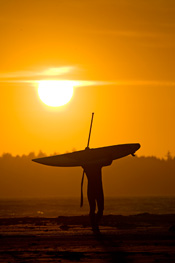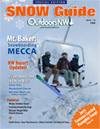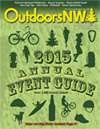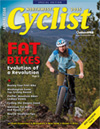SUP: Tips
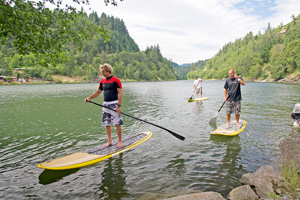
When in doubt – Paddle!
By Rob Casey (photos © S. Whitesell)
Always wear your leash
Losing your board can lead to a long swim, even in light wind. Coiled leashes stay on your board and don’t catch on kelp or lake milfoil. Straight leashes are safer for surfing.
Lifejackets/PFD’s
Always wear or have your lifejacket or Personal Flotation Device (PFD) on your board. The Coast Guard requires PFDs on non-surfing zones in the US. While it may look uncool or feel weird, the PFD keeps you warm and gives you options to store items such as an energy bar, hydration pack and camera.
Make sure your board fits
Get a board that fits your height and weight — it’ll help with your balance. For example, if you’re tall, start out with a 12-foot board at least 31 inches wide. Most common board sizes range from 10 –12 feet and start at 30 inches wide.
Try before you buy
Always demo boards and paddles prior to purchase. Ask shops for demos and go to kayaking and SUP symposiums and demo as many boards and paddles as possible.
Take a lesson
A good instructor will teach you how to carry the board, give you tips on gear, show you how to stand up, teach you about water and boating safety, and demonstrate basic directional control strokes such as going forward, backward, sideways and stopping.
Feeling tippy? Use the old paddling adage, “When in doubt, paddle.” You’re more stable when you’re paddling as momentum creates stability. Also, your paddle acts as a tripod.
If you’re standing still in rough water, put the paddle blade flat on the water or even take small strokes. If you’re so tippy where you’re about to fall in, take a few strokes quickly! If you stand up and are feeling off-balance, take a few strokes to gain stability.
Determine paddle length
To determine paddle length, stretch your arm straight above your head and flatten your hand. Your paddle handle should tuck snuggly below your hand. A few inches taller or shorter should be fine. If this feels too tall, imagine how the thickness of your board and the depth of the paddle blade in the water will affect paddle length. If your paddle is too short, you’ll likely to get a back problem. Surfers sometime prefer a shorter paddle while racers prefer longer for more power.
Water wear
In summer, beginners should consider a wetsuit such as a “farmer john,” full surfing wetsuit, or drysuit to get started on the Puget Sound, for example, where water temperatures rarely warm up. On warm days on the lakes, you’ll be fine in shorts and a t-shirt. In the fall and winter, dress for the water temperature. SUPers stay drier than kayakers so many wear much less once they gain their sea legs and have a solid understanding of the conditions they’re paddling in.
For surfing in the Northwest, consider a 4/3- to 5/4-mm wetsuit or full drysuit. Booties protect your feet from rocky beaches and barnacles. A PFD can provide core warmth in the winter. Neoprene gloves and a hood are essential in colder temperatures.
Weather forecasts
Learn how to understand weather forecasts. Many run to the beach when they see blue skies. In the Northwest, blue skies mean a high-pressure system which creates a strong northerly wind in the afternoon. If rough seas aren’t what you were hoping for, learn where and when to go to find the conditions that are more ideal for your skills.
NOAA (www.wrh.noaa.gov/) provides local real-time data online and a VHF radio service, which gives barometer readings, wind speed, water temperatures, forecasts, ocean swell size and other useful info. Check to see if your paddling spots also have a real time webcam to check for tide levels and wind speeds and direction. Webcams are great to confirm the conditions before you leave the house. Be smart: if you get to the water and the conditions are above your skill level, go out another day.
Boating right-of-way
Human-powered water craft such as kayaks and SUPs are not as fast as sailboats and power boats, thus SUPs should stay clear. Think before you decide to cross in the path of a speeding power boat; they don’t have brakes! If you’re in shipping lanes, freighters take a few miles to stop and won’t give you priority if you choose to cross in their path.
Rob Casey, a Seattle native and professional photographer, is the author of Stand Up Paddling, Flatwater to Surf and Rivers, Mountaineers Books. This is his first contribution to Outdoors NW.

